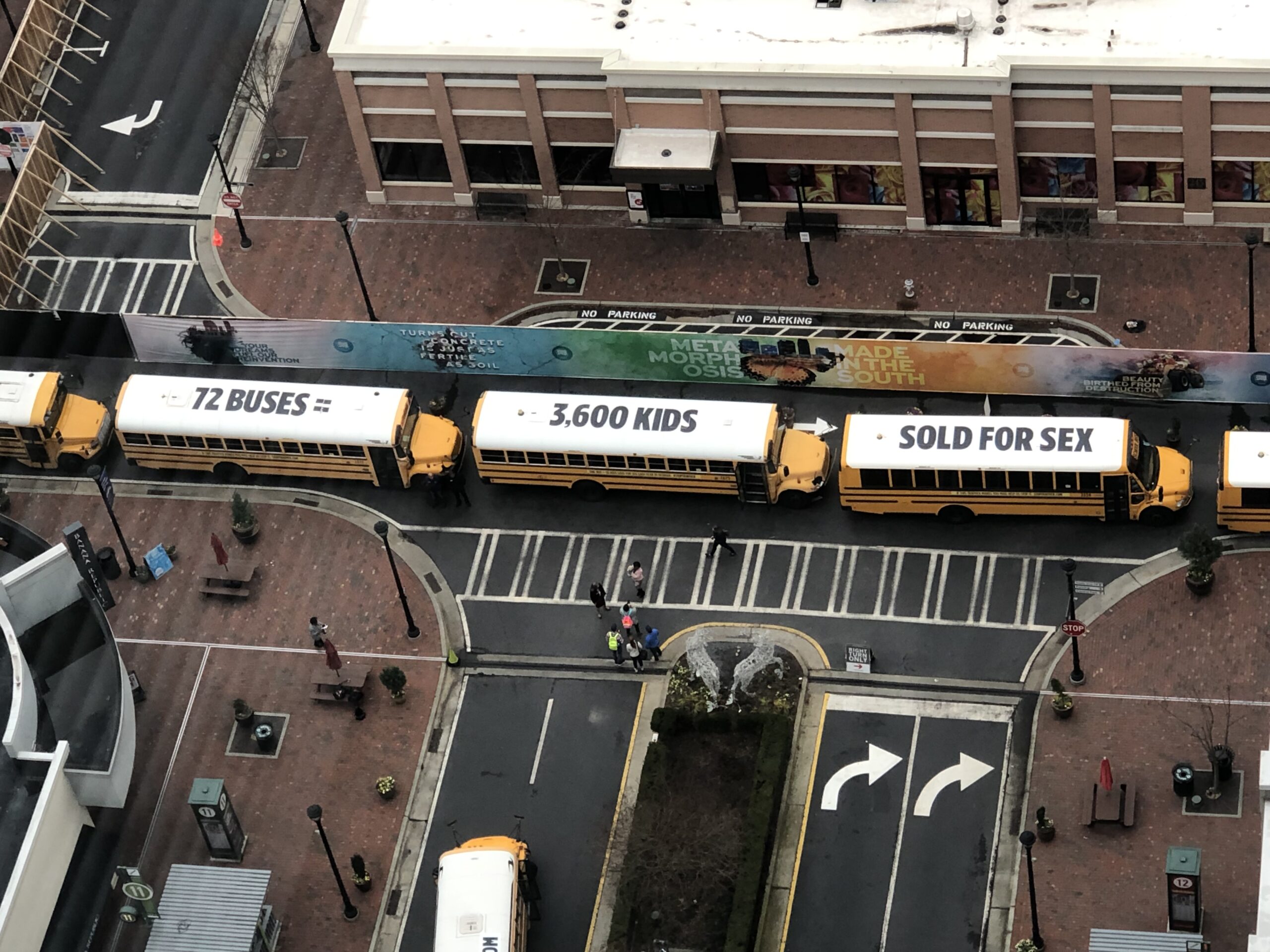Organizers of an Atlanta event meant to highlight the scope of the child sex trafficking problem in Georgia used 72 school buses to represent what they say is the number of trafficked children in the state.
To raise awareness, the buses were driven through Atlanta covered in anti-trafficking advocacy messages as, “a mile-long moving billboard,” according to the group that helped organize the event, Street Grace.
While experts and officials agree child sex trafficking is a horrific problem, the number at the heart of the event –3,600 Georgia children trafficked each year — is from a report that is almost a decade old. And the way the data was gathered?
“Well I think there’s some big methodological questions that come up,” said Jennifer O’Brien, an assistant professor at the Crimes Against Children Research Center at the University of New Hampshire. WABE asked her to review the 2011 study at the heart of the bus event.
A colleague of hers had previously reviewed it back when the report was first released. In a 2011 article by the Village Voice several independent experts expressed concerns about the design of the report. It had been conducted by an Atlanta-based market research consulting group, one with no experience studying prostitution.
The report is based not on documented cases of trafficked children, but on images posted on websites like Craigslist and Backpage. The former no longer offers adult classified ads and the latter was shut down by federal law enforcement. The consulting group counted and tried to survey the people who responded to ads with “young” women.
“The idea that these are young women, that can mean many different things. It doesn’t necessarily mean adolescents,” O’Brien said. She noted that ads on the internet don’t always correspond to reality.
“Really being able to pinpoint the age of the individual is pretty key,” she said. “We just don’t know from the study exactly how old these folks are, so we can’t know reliably what these numbers actually show us.”
The report itself likens its methods to counting the number of people in a neighborhood by looking at a picture of a park on a sunny day.
Other Figures
The number of trafficked Georgia children wasn’t the only statistic pulled from the report at the event.
“There’s research out there that says that 7,200 men a month pay for sex with minors in the state of Georgia,” Street Grace CEO Bob Rodgers said.
His group organized the buses with Carr and an array of local partners.
When asked, Rodgers said he was aware the study has been criticized by some researchers.
“Whatever the number is, for us, we feel like it’s an important enough issue that we need to address the issue, and we need to be there for the children of Georgia more so than debate the numbers that are being reported in different contexts,” he said.
Rodgers’ group presents to more than 7,000 people each year, and he said they would like to have access to more current and better research.
But O’Brien says no accurate count exists.
“It’s a hidden crime. It’s really hard to know the actual numbers,” O’Brien said.
She agrees that sex trafficking of children is a horrific problem.
“But when we cite estimates of the problem that are based on questionable methodology, or unsupported estimates, that’s a real issue, because we want to know what’s actually there,” she said.
The Crimes Against Children Research Center has issued repeated warnings about the most frequently cited statistics about child sex-trafficking. In recent years, The Washington Post has also done extensive fact checking on common advocacy claims.
“In general,” she said, “Bad data is even worse than no data.”
Especially, she said, when that data is used to frame responses to the problem.
Varying Perspectives
But lack of credible data hasn’t slowed down lawmakers.
At the event, Carr described the accumulating success of Georgia’s anti-trafficking movement.
“Last year, with our partners in the General Assembly, we were able to add harsh penalties for buyers, which gives prosecutors yet another weapon in the arsenal to prosecute these cases,” Carr said.
Governor-elect Brian Kemp echoed him a moment later.
“In the months to come, I look forward to working with the lawmakers and law enforcement to dismantle the criminal networks that are creating this supply and demand,” Kemp said.
Both are proponents of the idea that reducing “demand” by targeting buyers of commercial sex, will end trafficking. It’s an idea complicated by the fact that trafficking is a word that means different things depending on its context. An adult is only considered a victim of sex-trafficking if that individual has been coerced into sex work. A minor is legally identified as trafficked regardless of coercion.
One activist’s work with with current and former sex workers, some of whom survived by selling sex as minors, has left her with a different perspective than the leaders at the new year’s bus event.
“Increased policing looks like police officers raiding hotel rooms, raiding people’s homes, profiling homeless people on the street for prostitution or solicitation,” Toni-Michelle Williams, who directs the nonprofit Solutions Not Punishment Collaborative, said.
She said she believes law enforcement attention can disproportionately impact the vulnerable communities she represents, serves, and — as a black, transgender woman — is part of.
“Trans people have historically been pushed out, isolated, marginalized,” Williams said. “And so we don’t have access to resources like employment which often pushes us to have to participate in underground economies.”
She worries about how often messages about sex trafficking are paired with increasing criminal penalties rather than jobs and housing for the state’s most vulnerable.
Fear of arrest, and patterns of negative interactions with law enforcement, Williams said, “pushes folks more into isolation and to non-safe environments, where they face higher rates of violence, and away from family and peers and service providers who can actually support them.”









